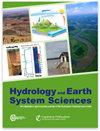通过基于水力学的图神经网络快速建立洪水时空模型
IF 5.8
1区 地球科学
Q1 GEOSCIENCES, MULTIDISCIPLINARY
引用次数: 0
摘要
摘要数值模拟是洪水模拟的可靠工具,但精确求解的计算成本高昂。近年来,研究人员探索了基于神经网络的数据驱动方法来克服这一限制。然而,大多数模型仅用于特定案例研究,而忽略了洪水波的动态演变。这就限制了模型在未经训练的地形和随时间变化的应用中的通用性。本文介绍了浅水方程图神经网络(SWE-GNN),这是一种基于 GNN 的水力学启发替代模型,可用于快速时空洪水建模。该模型利用了用于求解 SWE 和 GNN 的有限体积方法之间的类比关系。对于计算网格,我们将有限体积单元视为节点,相邻单元由边连接,从而创建一个图。输入由域的地形属性和初始水力条件决定。然后,GNN 通过学习到的局部函数决定如何在单元之间交换流量。我们通过堆叠多个 GNN 层来克服时间步长限制,从而扩大考虑的空间,而不是提高时间分辨率。我们还提出了一种多步超前损失函数和课程学习策略,以提高稳定性和性能。我们使用随机生成的数字高程模型中的二维堤坝决口洪水模拟数据集验证了这一方法,该数字高程模型是由高保真数值解算器生成的。SWE-GNN 模型可预测未见地形的洪水时空演变,水深的平均时间误差为 0.04 m,单位排水量的平均时间误差为 0.004 m2 s-1。此外,与训练集相比,它还能很好地泛化到未知的破口位置、更大的区域和更长的时间段,表现优于其他深度学习模型。此外,SWE-GNN 的计算速度比数值求解器快两个数量级。我们的框架为在具有空间不确定性的时间敏感型应用中取代数值求解器打开了一扇新的大门。本文章由计算机程序翻译,如有差异,请以英文原文为准。
Rapid spatio-temporal flood modelling via hydraulics-based graph neural networks
Abstract. Numerical modelling is a reliable tool for flood simulations, but accurate solutions are computationally expensive. In recent years, researchers have explored data-driven methodologies based on neural networks to overcome this limitation. However, most models are only used for a specific case study and disregard the dynamic evolution of the flood wave. This limits their generalizability to topographies that the model was not trained on and in time-dependent applications. In this paper, we introduce shallow water equation–graph neural network (SWE–GNN), a hydraulics-inspired surrogate model based on GNNs that can be used for rapid spatio-temporal flood modelling. The model exploits the analogy between finite-volume methods used to solve SWEs and GNNs. For a computational mesh, we create a graph by considering finite-volume cells as nodes and adjacent cells as being connected by edges. The inputs are determined by the topographical properties of the domain and the initial hydraulic conditions. The GNN then determines how fluxes are exchanged between cells via a learned local function. We overcome the time-step constraints by stacking multiple GNN layers, which expand the considered space instead of increasing the time resolution. We also propose a multi-step-ahead loss function along with a curriculum learning strategy to improve the stability and performance. We validate this approach using a dataset of two-dimensional dike breach flood simulations in randomly generated digital elevation models generated with a high-fidelity numerical solver. The SWE–GNN model predicts the spatio-temporal evolution of the flood for unseen topographies with mean average errors in time of 0.04 m for water depths and 0.004 m2 s−1 for unit discharges. Moreover, it generalizes well to unseen breach locations, bigger domains, and longer periods of time compared to those of the training set, outperforming other deep-learning models. On top of this, SWE–GNN has a computational speed-up of up to 2 orders of magnitude faster than the numerical solver. Our framework opens the doors to a new approach to replace numerical solvers in time-sensitive applications with spatially dependent uncertainties.
求助全文
通过发布文献求助,成功后即可免费获取论文全文。
去求助
来源期刊

Hydrology and Earth System Sciences
地学-地球科学综合
CiteScore
10.10
自引率
7.90%
发文量
273
审稿时长
15 months
期刊介绍:
Hydrology and Earth System Sciences (HESS) is a not-for-profit international two-stage open-access journal for the publication of original research in hydrology. HESS encourages and supports fundamental and applied research that advances the understanding of hydrological systems, their role in providing water for ecosystems and society, and the role of the water cycle in the functioning of the Earth system. A multi-disciplinary approach is encouraged that broadens the hydrological perspective and the advancement of hydrological science through integration with other cognate sciences and cross-fertilization across disciplinary boundaries.
 求助内容:
求助内容: 应助结果提醒方式:
应助结果提醒方式:


